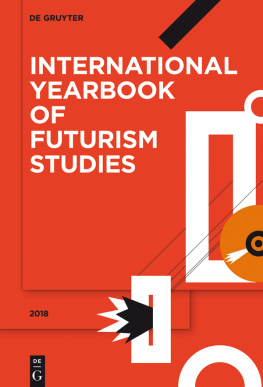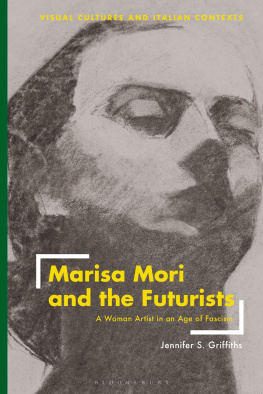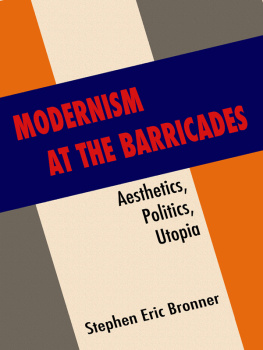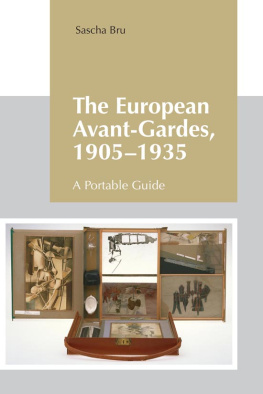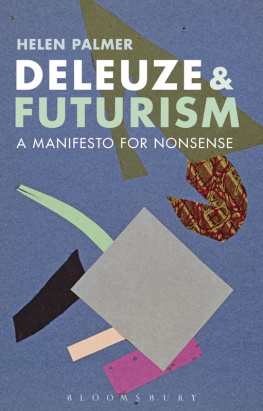Contents
Guide

International Yearbook of Futurism Studies
International Yearbook of Futurism Studies

Edited by
Gnter Berghaus
Editorial Board
Matteo DAmbrosio Marjorie Perloff Irina Suboti
Jorge Schwartz
Contributing Editors
Matteo Fochessati Rubn Gallo Chris Michaelides ()
Przemysaw Stroek Pierantonio Zanotti

ISBN 978-3-11-057463-0
e-ISBN (PDF) 978-3-11-057536-1
e-ISBN (EPUB) 978-3-11-057528-6
ISSN 2192-0281
Library of Congress Cataloging-in-Publication Data
A CIP catalog record for this book has been applied for at the Library of Congress.
Bibliographic information published by the Deutsche Nationalbibliothek
The Deutsche Nationalbibliothek lists this publication in the Deutsche Nationalbibliografie; detailed bibliographic data are available on the Internet at http://dnb.dnb.de.
2018 Walter de Gruyter GmbH, Berlin/Boston
www.degruyter.com
Gnter Berghaus
Editorial
The first section of this eighth volume of the International Yearbook of Futurism Studies contains four studies that present new research into Futurist connections to artists and artistic movements in Great Britain, Hungary and Sweden. Sze Wah Sarah Lee s examination of Futurism and the English Arts: Imagism and Vorticism explores two artistic movements that developed in England in the early 1910s in opposition to Edwardian culture and under the influence of Futurism and other avant-garde movements in continental Europe. While this yearbook has repeatedly addressed Futurisms links to Vorticism, it has paid less attention to Imagism, a contemporaneous poetic school that did not possess the same radical features as other coeval movements. As Sze Lee demonstrates, Futurist innovations did not escape the notice of the Imagists, and the internal rivalry amongst its members over its direction subsequently drove some of the poets to adopt many of Futurisms publicity strategies and modes of commodification. Sze Lee explores the manifold interactions between Futurism, Imagism and Vorticism, discussing the many similarities and differences between the three movements and demonstrating that their relations were far from simple imitations or outright rejections.
Gbor Dob s study Framing Futurism in Hungary (19091944) expands on two surveys of Hungarian responses to Futurism published in previous volumes of this yearbook. enrol Italy as an ally in the governments attempts to make revisionist territorial claims. This way, Futurism, which had been initially condemned by Hungarian cultural critics as unintelligible, crazy or alien, came to be re-interpreted and, by the mid-1920s, turned into an embodiment of the modern and at the same time conservative Fascist Italy.
Quite different in nature and approach is Pter Molnos s essay Hug Scheiber: Futurism in the Rhythm of Jazz. Scheiber will be known to readers of the yearbook from Ilona Frieds essay on Marinettis Visits to Budapest, 1931, 1932 and 1933, which reported on this painters participation in the Mostra nazionale darte futurista held in 1933 in Rome and the echoes that it received in Italy. Scheiber is highly appreciated today amongst collectors in Hungary and fuses in many of his works an attractive mixture of stylistics traits taken from Expressionism, Futurism and Art Dco. Molnos, who published a 500-page tome on Scheiber, summarizes in this essay what he discovered about the painters Futurist connection and how he processed his experiences of Big-City life and the popular arts of cabarets, music-halls, circuses and dance halls in his paintings. It has often been said that Futurism was never a good business proposition for painters; Molnos, in his study of Scheiber, substantiates this popular wisdom by discussing the question of why an internationally successful artist could fail to achieve commercial success in his native country and was reduced to bartering his paintings for pig halves or the price of a meal.
Annika hrner s examination of Arturo Ciacelli (18831966) and his Activities in Denmark and Sweden addresses one of several Futurist artists who attempted to pursue a career outside Italy (e. g. Ivo Pannaggi in Norway, Nanni Leone Castelli and Athos Cesarini in the USA, Luigi Russolo and Enrico Prampolini in France, Rugero Vasari in Germany, to name but a few). Ciacelli, who has found little attention so far, spent time in Paris in the circle of Robert and Sonia Delaunay before trying to establish himself in Scandinavia as an artist, publicist and gallerist. Ciacellis embrace of Futurism was less evident in his painterly work than in his theoretical statements, the most important of which was a partial translation into Swedish of the Technical Manifesto of Futurist Painting via a 1912 French edition, to which he added his own signature. hrner presents Ciacellis activities in Stockholm, Lund and Copenhagen, discusses the artists attempts to foster trans-national exchange of avant-garde formations and discusses his Futurist-Mlarnes Manifest of 1913.
Amotz Giladi s study Futurism and Pan-Latin Ideology: A Contradictory Appropriation focusses on Futurist links to an ideology that developed in Italy and France in the nineteenth century, had several new developments in the first half of the twentieth century and counted Marinetti as one of its more prominent representatives. On the surface, Marinettis desire to deliver Italy from the weight of the past seems to be in contradiction to the appropriation of the ancient Roman heritage pursued by the Pan-Latinists. However, Marinetti was active in an environment strongly marked by the notion of a Latin Renaissance, most noticeably through his collaboration with the Franco-Italian periodical, Anthologie-Revue de France et dItalie (18971900). As early as 1908, the notion of Latinity appeared in reviews written by Paolo Buzzi for Marinettis periodical Poesia . Later, the Futurists sought to gain legitimacy within the culture of the Fascist rgime by contributing to the cult of Latinity promoted by Mussolini in initiatives such as the Exhibition of the Fascist Revolution (193233) and the citt di fondazione (Foundation Cities). Marinetti, for instance, participated as Italian representative in a meeting held in Paris to create a Latin Bloc. Another example is Marinettis collaboration with the book series Collezione Romana , for which he translated Tacituss Germania . Marinetti also sanctioned Latinity in two official mouthpieces of his movement, the journals Futurismo: Quindicinale dellartecrazia italiana (193233), and Mediterraneo futurista (193843). As Giladi shows, Marinetti strove to demonstrate that Latinity was not necessarily synonymous with traditional values and could even be considered modern and Futurist.
As in previous volumes, we seek to give representation to a variety of artistic disciplines in which Futurism played a notable rle. This time, we present a study by Ashley Gardini on The Reception of Futurist Architecture after the Second World War. The author links the rediscovery of Antonio SantElias Messaggio (Message, 1914) during the 1950s and the ensuing scholarly debate surrounding the transformation of this text into the subsequent Manifesto of Futurist Architecture (1914) to a revived interest in Futurist themes in the work of architects such as Buckminster Fuller in the United States, Archigram in Britain, Metabolism in Japan and Archizoom in Italy. SantElias approach to architecture envisioned a progressive application of technology and novel building materials in order to shape an urban environment for a modern society. This approach has continued to resonate with architects after 1945, and once Futurist theory of architecture became accessible again in the 1960s, it began to affect the works and projects of several small avant-garde architectural cooperatives. As Gardinis essay demonstrates, the Futurists may have failed to develop a cohesive architectural aesthetic and had little success in translating their ideas into actual buildings, their theories continued to influence architects to the present-day.

